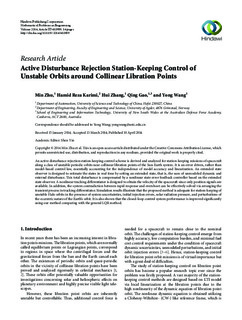| dc.contributor.author | Zhu, Min | |
| dc.contributor.author | Karimi, Hamid Reza | |
| dc.contributor.author | Zhang, Hui | |
| dc.contributor.author | Gao, Qing | |
| dc.contributor.author | Wang, Yong | |
| dc.date.accessioned | 2015-03-19T11:31:08Z | |
| dc.date.available | 2015-03-19T11:31:08Z | |
| dc.date.issued | 2014 | |
| dc.identifier.citation | Zhu, M., Karimi, H. R., Zhang, H., Gao, Q., & Wang, Y. (2014). Active disturbance rejection station-keeping control of unstable orbits around collinear Libration points. Mathematical Problems in Engineering, 2014. doi: 10.1155/2014/410989 | nb_NO |
| dc.identifier.issn | 1024123X | |
| dc.identifier.uri | http://hdl.handle.net/11250/279719 | |
| dc.description | Published version of an article in the journal: Mathematical Problems in Engineering. Also available from the publisher at: http://10.1155/2014/410989 | nb_NO |
| dc.description.abstract | An active disturbance rejection station-keeping control scheme is derived and analyzed for station-keeping missions of spacecraft along a class of unstable periodic orbits near collinear libration points of the Sun-Earth system. It is an error driven, rather than model-based control law, essentially accounting for the independence of model accuracy and linearization. An extended state observer is designed to estimate the states in real time by setting an extended state, that is, the sum of unmodeled dynamic and external disturbance. This total disturbance is compensated by a nonlinear state error feedback controller based on the extended state observer. A nonlinear tracking differentiator is designed to obtain the velocity of the spacecraft since only position signals are available. In addition, the system contradiction between rapid response and overshoot can be effectively solved via arranging the transient process in tracking differentiator. Simulation results illustrate that the proposed method is adequate for station-keeping of unstable Halo orbits in the presence of system uncertainties, initial injection errors, solar radiation pressure, and perturbations of the eccentric nature of the Earth's orbit. It is also shown that the closed-loop control system performance is improved significantly using our method comparing with the general LQR method. © 2014 Min Zhu et al. | nb_NO |
| dc.language.iso | eng | nb_NO |
| dc.publisher | Hindawi | nb_NO |
| dc.rights | Navngivelse 3.0 Norge | * |
| dc.rights.uri | http://creativecommons.org/licenses/by/3.0/no/ | * |
| dc.title | Active disturbance rejection station-keeping control of unstable orbits around collinear Libration points | nb_NO |
| dc.type | Journal article | nb_NO |
| dc.type | Peer reviewed | nb_NO |
| dc.subject.nsi | VDP::Technology: 500::Mechanical engineering: 570 | nb_NO |
| dc.source.pagenumber | 14 p. | nb_NO |
| dc.source.journal | Mathematical Problems in Engineering | nb_NO |
| dc.identifier.doi | 10.1155/2014/410989 | |

